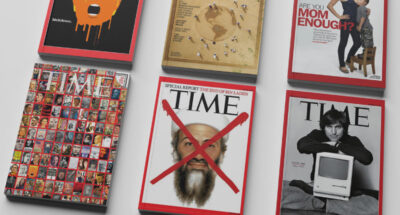
Communication: Let’s be clear, we should cut out the clichés
The soulless language of management speak leads to uninspired and disengaged teams. Here’s how to sharpen your language skills to become a more effective leader....
Audio available

by Philip Thomas Published July 31, 2024 in Creativity • 9 min read
Apple's ad for iPad Pro faced a huge backlash and was quickly withdrawn. (Image: Apple/YouTube)
Apple released its new iPad Pro in May with an ad titled “Crush.” You may have missed it – it was pulled almost immediately. The 60-second spot features an array of cultural and artistic objects, including a trumpet and a piano, a typewriter, and cans of paint – all of it being crushed to smithereens in a hydraulic press. As the machine slowly pulverizes these symbols of human creativity, Sonny & Cher’s All I Ever Needed Was You rings out cheerfully in the background. The ad is supposed to represent all the creative things that users can do with the latest iPad – its thinnest and most powerful to date. And Apple likely imagined that their concept … well, crushed it! But the backlash was immediate and widespread, with Hollywood heavyweight Hugh Grant captioning the commercial on X: “The destruction of the human experience. Courtesy of Silicon Valley.” Within 48 hours, Apple had pulled the global TV campaign with VP Tor Mhyren apologizing for having “missed the mark”. (The ad can still be viewed on YouTube, where it continues to enjoy some notoriety.)
The Crush debacle illuminates something of the cultural morass that organizations, brands, and the creative industries must navigate in our choppy, partisan, and increasingly polarized world –a world in which culture wars on both sides of the Atlantic have organized customer bases in opposing camps; in which disruption along technological, socioeconomic, and geopolitical fault lines is continuously redrawing the rules of engagement. In today’s world, where everybody has a point of view and access to social media, brand owners have a tightrope to walk between buzz and backlash.
How do you position your product, service, or organization without alienating at least some of your audience (even as you delight others)? How do you tune in to one camp’s priorities and preferences without simultaneously turning off the others? How do you begin to talk about the issues that matter: equality and inclusion, sustainability, and climate change, or the importance of the human experience in the face of digital disruption?
The short answer is to go there with the utmost caution or, better still, don’t go there at all.

As consumers have become more polarized and partisan in the US, businesses are moving away from hot potato content in their advertising, marketing, and positioning efforts. Where it used to be seen as a competitive advantage for organizations to emphasize the good they do for the world – their commitment to diversity, equality, inclusion, and sustainability – CEOs today are far more reluctant to go there. Why? Because these topics have become lightning rods for criticism from certain portions of their audience, it’s a risk simply not worth taking. The advice from astute brand managers and marketers in the US has become this: by all means, do the DE&I and sustainability work if it matters to your business; just don’t talk about it.
Things are a little different in Europe, where regulations around sustainability and climate impact have become more stringent. Here, there is more of an imperative to report on governance and environmental issues, which is an incentive to weave these things into marketing and communications. Even so, organizations have become extremely cautious about broaching any issue that might rile one side of their customer base – no matter how much you resonate with the other. But the question remains: how do you create buzz and stay relevant to the issues that matter to your audience without straying into divisive territory? And on both sides of the Atlantic, brands do get into hot water from time to time, not least because the creative industries that organizations work with – the brand and advertising agencies that are hired to create campaigns – are peopled mainly by professionals who sit squarely in one camp. You can guess which camp that is. Creatives tend to be more liberal in their thinking and political allegiances, more aware and aligned with efforts and activism on the issues of climate, equality, and inclusion.
The Bud Light imbroglio strikes me as a good example of an in-house creative team very much at odds with a brand’s core audience. When America’s best-selling beer sponsored transgender influencer Dylan Mulvaney on Instagram, the blowback from its US customer base was huge. Critics accused the brand of going “woke,” conservative-leaning customers declared a national boycott, and sales plummeted more than 10%. Interestingly, outside the States, sales increased by nearly 17%.
In our disrupted times, prone to culture wars that cut right across product and brand preferences, it feels like organizations and the creative industries can’t win with one set of customers without losing with another. Or can they?

Thoughtful organizations understand the need to recalibrate their marketing and advertising efforts and rein in their messages around the specifics of the products and services that they supply. Unilever, for instance, has received plenty of blowback in its time for purpose-led communications. While some of its brands might have a strong fit with purpose (Dove, for one, has promoted “real beauty” for “real women” in its communications forever), the organization has been publicly criticized for shoehorning positive impact messages across all of its brands – even by its investors. In 2022, the boss of a major investor, Fundsmith, said this of Unilever: “A company which feels it has to define the purpose of Hellmann’s mayonnaise has, in our view, clearly lost the plot.”
When Hein Schumacher took over as Unilever CEO in 2023, one of the first statements he made was that the company was to stop “force-fitting” purpose across its entire brand portfolio, adding that he hoped this would simplify the job of brand owners and creative teams. And this is a pullback position that we are seeing from many other organizations.
Procter & Gamble is the world’s biggest advertiser in terms of dollars. When Chief Brand Officer Mark Pritchard took the stage at Cannes Lions in 2023, he made it very clear that, in his view, the company had overdone the purpose-led work in the past. Instead, it would be doubling down on product strength and superiority. His message was simple, and it’s a message that is starting to resonate across the creative industries: not every brand can save the world. If you’re making cleaning products, don’t peddle so many messages about the environment or gender equality – messages that can set you up for a fall, depending on who’s receiving them. Instead, talk about how well your product cleans the floor.
Does this mean that organizations can’t be creative about their brands? Not at all. If anything, I think it’s probably liberating for creative people who no longer have to shoehorn these messages into places they don’t belong. Something we are seeing across creative industries and in our data is that “save the world” is being replaced by a much broader spread of creativity. We’re seeing ads focused on really useful product and service features. We’re also seeing humor being used more liberally. Instead of Budweiser making the world a more tolerant, inclusive, and fairer place, we’re starting to see Budweiser making people fall off their seats laughing. We’re seeing funnier ads, sillier ads, ads that are zany or emotional, and ads designed to make people laugh or cry. And creatively, that’s probably a more challenging thing to do.
Perhaps above all, we’re seeing advertising and marketing efforts with a much closer tie to the actual audiences that brands are trying to reach; and what they want those audiences to think, feel, or do.

“A company which feels it has to define the purpose of Hellmann’s mayonnaise has, in our view, clearly lost the plot. ”Fundsmith's Terry Smith
In our polarized world, brands have a complex social and cultural morass to negotiate. Reining in overblown messages about the world, cleaving to product superiority, and using humor as a tool to reach minds and hearts are all tactics increasingly being used to greater effect. But behind the tactics, an even bigger shift is taking place in the creative process – and that’s the growing importance of strategy.
Strategy is the first pillar of the creative process. The other two are execution and measurement. In the creative world, strategy is about building absolute clarity on who your brand is for – who your actual audience is. In today’s climate, the time spent on strategy needs to go through the roof because leaders, be they CMOs or agency directors, need to comprehensively align the campaigns they create, the people making those campaigns, and the people that those campaigns target.
This doesn’t mean going all out on one side of the cultural divide over the other. It does mean putting guard rails in place around the brand and target consumer and the kinds of messages you want to share about both.
Reining in your messages, focusing on the products and services, and prioritizing strategy above all are critical guard rails that will help keep you and your brand on track in these choppy times. Beyond that, looking at our work with industry leaders, CEOs, CMOs, and brand owners at Cannes Lions, there are three core mindsets or attitudes that can help leaders spot risks as well as opportunities and keep their brands and audiences aligned in changing times.
There still seems to be some debate around whether leaders should ask questions because it might be construed as weakness or indecision. There may be situations where this makes some sense, but curiosity generally furnishes leaders with a competitive advantage in our disrupted and polarized world. Whether it’s changing consumer habits, preferences, and partisanship, or digital disruption and the advent of generative AI – poised as it is to change the game in the creative industries – there is so much that leaders need to make sense of and learn. Curiosity must be a core leadership trait for CEOs and their senior leadership teams: the more eyes you have on the future the better.
As consumer behavior has evolved and changed, brand owners have had to shift with the times. What worked for you yesterday won’t necessarily work for you today, let alone tomorrow. Whether it’s emerging client needs, new ways to engage with your customers, or finding better ways to deploy technologies such as Gen AI, it’s incumbent on CEOs and CMOs to be open to opportunities and to be highly flexible in the ways they are prepared to pivot as things change. That goes for everything from your decision-making to your leadership style to your business model. At Cannes Lions, we are looking at ways to make our proprietary data open now to customers who need to build out large language models – something we might not have considered as a business model just a few years ago.
Our world is in a state of permanent and continuous flux. It’s hard to predict how things like customer preferences and AI will reshape our operational and competitive landscape from one day to the next. But whatever way things pan out, it’s critical to have a sense of how disruption might impact your business – and how you will adapt. Culture wars are one thing, and technology is another. It’s possible that, as GenAI takes over more of the so-called grunt work in the brand-customer interface, the value of human interaction, human creativity, and the stardust of humanity will increase exponentially. For the creative industries and those working in-house to build brands and their stories, the challenge will be to figure out what we can bring as human beings that keep things special. That is where the opportunities are going to be.

Chief Executive of Ascential plc
Philip Thomas is Chief Executive of Ascential plc, home to LIONS, WARC, Contagious, Acuity Pricing, and Money20/20. He is Chairman of both Cannes Lions – having been CEO of Lions Festivals for 10 years, between 2006-2016 – and Media Trust.

May 5, 2025 • by Peter J. Meyers in Creativity
The soulless language of management speak leads to uninspired and disengaged teams. Here’s how to sharpen your language skills to become a more effective leader....
 Audio available
Audio available
April 22, 2025 • by D W Pine in Creativity
Responsible for TIME magazine’s iconic covers, D W Pine explores his creative process and shares insights on how to cut through the noise and make an impact....

January 28, 2025 • by Su-Mei Thompson in Creativity
As campaign disasters at Apple, Bud Light, and Jaguar demonstrate, boards shy away from marketing oversight at their peril....
 Audio available
Audio available
October 10, 2024 • by George Kohlrieser in Creativity
Command and control kill. If you want your employees to express their creativity, build corporate playgrounds where they can experiment, take risks, and embrace failure....
Explore first person business intelligence from top minds curated for a global executive audience